Hi,
Need help answering the question in the attached screen shot.
Binara
Lima beans
This topic has expert replies
GMAT/MBA Expert
- Brent@GMATPrepNow
- GMAT Instructor
- Posts: 16207
- Joined: Mon Dec 08, 2008 6:26 pm
- Location: Vancouver, BC
- Thanked: 5254 times
- Followed by:1268 members
- GMAT Score:770
The answer is, indeed, DOf the students who eat in a certain cafeteria, each student either likes or dislikes lima beans and each student either like or dislikes Brussels sprouts. Of theses students, 2/3 dislike lima beans; and of those who dislike lima beans, 3/5 also dislike Brussels sprouts. How many of the students like Brussels sprouts but dislike lima beans?
(1) 120 students eat in the cafeteria
(2) 40 of the students like lima beans.
We can use the Double Matrix Method to solve this question. This technique can be used for most questions featuring a population in which each member has two characteristics associated with it.
Here, we have a population of students, and the two characteristics are:
- like Brussels sprouts or dislike Brussels sprouts
- like lima beans or dislike lima beans
So, we can set up our diagram as follows:
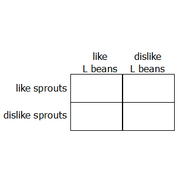
Target question: How many of the students like Brussels sprouts but dislike lima beans?
Let's place a STAR in the box representing those students who like Brussels sprouts but dislike lima beans.
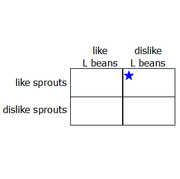
Since we don't know the TOTAL NUMBER of students, let's let x represent the total student population. So, we'll add that to our diagram as well.
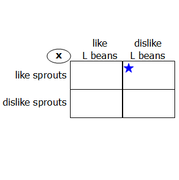
Given: 2/3 dislike lima beans
So, (2/3)x = total number of students who dislike lima beans
This means the other 1/3 LIKE lima beans. In other words, (1/3)x = total number of students who LIKE lima beans.
We'll add that to the diagram:
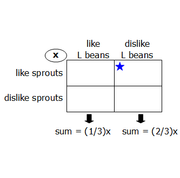
Given: Of those who dislike lima beans, 3/5 also dislike Brussels sprouts
If (2/3)x = total number of students who dislike lima beans, then (3/5)(2/3)x = total number of students who dislike lima beans AND dislike Brussels sprouts.
(3/5)(2/3)x simplifies to (2/5)x, so we'll add that to our diagram:
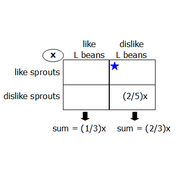
Finally, since the two boxes in the right-hand column must add to (2/3)x, we know that the top-right box must = (4/15)x [since (2/3)x - (2/5)x = (4/15)x]
So, we can add that to the diagram:
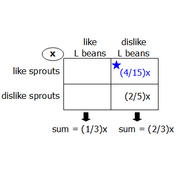
Great! We're now ready to examine the statements.
Statement 1: 120 students eat in the cafeteria
In other words, x = 120
Plug x = 120 into the top-right box to get: (4/15)(120) = 32
So, there are 32 students who like Brussels sprouts but dislike lima beans.
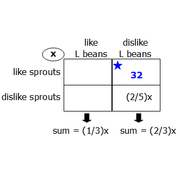
Since we can answer the target question with certainty, statement 1 is SUFFICIENT
Statement 2: 40 of the students like lima beans.
The left-hand column represents students who like lima beans.
In total, (1/3)x = total number of students who LIKE lima beans.
So, statement 2 is telling us that (1/3)x = 40
We can solve the equation to conclude that x = 120
Once we know the value of x, we can determine the number of students who like Brussels sprouts but dislike lima beans (we already did so in statement 1)
Since we can answer the target question with certainty, statement 2 is SUFFICIENT
Answer = D
------------------------------
To learn more about the Double Matrix Method, watch our free video: https://www.gmatprepnow.com/module/gmat- ... ems?id=919
Once you're familiar with this technique, you can attempt these additional practice questions:
Easy Problem Solving questions
- https://www.beatthegmat.com/the-aam-aadm ... 72242.html
- https://www.beatthegmat.com/finance-majo ... 67425.html
Medium Problem Solving questions
- https://www.beatthegmat.com/probability- ... 73360.html
- https://www.beatthegmat.com/posted-speed ... 72374.html
- https://www.beatthegmat.com/motel-t271938.html
- https://www.beatthegmat.com/of-the-appli ... 70255.html
- https://www.beatthegmat.com/opening-nigh ... 64869.html
- https://www.beatthegmat.com/ds-french-ja ... 22297.html
Difficult Problem Solving questions
- https://www.beatthegmat.com/ratio-problem-t268339.html
- https://www.beatthegmat.com/overlapping- ... 65223.html
- https://www.beatthegmat.com/fractions-t264254.html
- https://www.beatthegmat.com/overlapping- ... 64092.html
- https://www.beatthegmat.com/mba/2011/05/ ... question-2
Easy Data Sufficiency questions
- https://www.beatthegmat.com/for-what-per ... 70596.html
- https://www.beatthegmat.com/ds-quest-t187706.html
Medium Data Sufficiency questions
- https://www.beatthegmat.com/sets-matrix-ds-t271914.html
- https://www.beatthegmat.com/each-of-peop ... 71375.html
- https://www.beatthegmat.com/a-manufacturer-t270331.html
- https://www.beatthegmat.com/in-costume-f ... 69355.html
- https://www.beatthegmat.com/mba/2011/05/ ... question-1
Difficult Data Sufficiency questions
- https://www.beatthegmat.com/double-set-m ... 71423.html
- https://www.beatthegmat.com/sets-t269449.html
- https://www.beatthegmat.com/mba/2011/05/ ... question-3
Cheers,
Brent
GMAT/MBA Expert
- Jeff@TargetTestPrep
- GMAT Instructor
- Posts: 1462
- Joined: Thu Apr 09, 2015 9:34 am
- Location: New York, NY
- Thanked: 39 times
- Followed by:22 members
Solution:binaras wrote:Hi,
Need help answering the question in the attached screen shot.
Of the students who eat in a certain cafeteria, each student either likes or dislikes lima beans and each student either like or dislikes Brussels sprouts. Of theses students, 2/3 dislike lima beans; and of those who dislike lima beans, 3/5 also dislike Brussels sprouts. How many of the students like Brussels sprouts but dislike lima beans?
(1) 120 students eat in the cafeteria.
(2) 40 of the students like lima beans.
Binara
The easiest way to solve this problem is to set up a double set matrix. In our matrix we have two main categories: lima beans and Brussels sprouts. More specifically, our table will be labeled with:
1) Likes lima beans (Like LB)
2) Dislikes lima beans (Dislike LB)
3) Likes Brussels sprouts (Like BS)
4) Dislikes Brussels sprouts (Dislike BS)
(To save room on our table headings we will use the abbreviations for these categories)
We are not given the total number of students in the question stem, so we label the total number of students as T.
Thus, we know:
Total students = T
Dislikes lima beans = (2/3)T
We are next given that of those who dislike lima beans, 3/5 also dislike Brussels sprouts. Thus we can say that (3/5)(2/3)T = (2/5)T dislike lima beans and dislike Brussels sprouts.
We are trying to determine the number of the students who like Brussels sprouts but dislike lima beans.
Let's fill all this information into a table. Note that each row sums to create a row total, and each column sums to create a column total. These totals also sum to give us the grand total, designated by T at the bottom right of the table.

Since (4/15)T represents the number of students who like Brussels sprouts but dislike lima beans, we see that if we know the value of T, then we can determine the number students who like Brussels sprouts but dislike lima beans.
Statement One Alone:
120 students eat in the cafeteria.
We see that T = 120. Since we have a value for T, we can determine the number students who like Brussels sprouts but dislike lima beans. Statement one alone is sufficient. We can eliminate answers B, C, and E.
Statement Two Alone:
40 of the students like lima beans.
From looking at our chart, we see that (1/3)T students like lima beans. Thus we can say:
(1/3)T = 40
T = 120
Once again, because we have a value for T, we can determine the number of students who like Brussels sprouts but dislike lima beans. Statement two alone is sufficient.
The answer is D
Jeffrey Miller
Head of GMAT Instruction
[email protected]

See why Target Test Prep is rated 5 out of 5 stars on BEAT the GMAT. Read our reviews




















